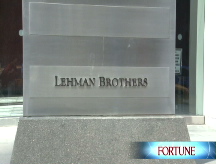A Lehman 'bad bank' may be good
The key to a rescue of Lehman Brothers may lie in the government convincing healthier rivals to pay to isolate its bad assets.

You may think there are enough bad banks out there as it is. But if federal officials have their way, there may soon be at least one more- and, believe it or not, that's a good thing.
As part of the frenzied effort to stave off a collapse at Lehman Brothers (LEH, Fortune 500), regulators are reportedly pitching industry executives on a new variation of an old theme: splitting the good assets from the bad, and placing the bad assets into a new company that will hold them until the markets turn up.
By selling off the good Lehman to another bank while segregating bad assets - mostly loans and securities tied to the sliding commercial real estate and free-falling residential mortgage markets - officials hope to prevent a fire sale that would further depress prices. That in turn could lead to additional writedowns at other financial firms, which have already taken hundreds of billions of losses and raised a similar amount of new capital.
Sound too good to be true? Well, there is a catch.
The bad bank, like any financial institution, needs to be supported by equity capital - and in this case, it seems that would have to be supplied by healthier banks. While execs at Lehman's rivals surely don't want to part with hundreds of millions of dollars with no near-term prospect of returns, the assumption is that everyone shares an interest in keeping the financial system from the disaster that might follow a Lehman bankruptcy.
Can the officials, led by Federal Reserve Bank of New York President Timothy Geithner and Treasury Secretary Henry Paulson, pull it off? Investors better hope so, given how the financial markets and the economy as a whole are straining under the burden of the housing bust.
The economy has slowed sharply this year, with nonfarm payrolls shrinking in each of the past eight months and the unemployment rate having risen more than a percentage point to a recent 6.1%. Numerous banks, including California mortgage lender IndyMac, have failed in recent months.
Meanwhile, mortgage-related problems continue to fester. Shares in brokerage firm Merrill Lynch (MER, Fortune 500), insurance giant AIG (AIG, Fortune 500) and Seattle thrift Washington Mutual (WM, Fortune 500) each lost more than a third of their value last week, as investors bet the companies will need to raise more capital or otherwise act to contain the damage.
None of these firms may need to try the good bank/bad bank split. Merrill in July sold a $30 billion chunk of bad mortgage assets at 22 cents on the dollar. WaMu last week ditched its longtime CEO and said it has enough money to weather the mortgage industry storm. AIG, which hired a new chief in June, is expected to outline its latest response to the crisis Monday.
But given the sheer scale of mortgage problems, it seems likely that Lehman won't be the last time anyone tries to put a fence around housing assets.
The idea of splitting off troubled assets into a separate institution isn't new. Mellon Bank, a Pittsburgh-based predecessor to Bank of New York Mellon (BK, Fortune 500), famously split off some of its bad loans in the 1988 spinoff of Grant Street National Bank, with the help of a capital infusion from private equity firm Warburg Pincus.
Grant Street was eventually wound down and Mellon returned to health in the 1990s as it moved into the fast-growing asset management business.
Getting industry execs to pitch in also has precedent. The New York Fed organized a 1998 rescue of the hedge fund Long Term Capital Management after it crumbled under the weight of bad bets on Russian bonds and massive leverage. Banking firms injected $3.5 billion into LTCM to prevent a fire sale of its assets.
Lehman itself proposed a variation of the good bank-bad bank split last Wednesday, when CEO Dick Fuld - confronted by the free fall of Lehman's stock - rushed out a plan to separate $30 billion in commercial real estate loans from the rest of Lehman. The result of that and other moves, Lehman execs said, would be to create a cleaner, less risky investment bank sometime next year.
But if anything, Lehman's own plan seems to have failed in part because it understated the scale of risk investors see on the bank's balance sheet.
Reports this weekend say the bad bank being considered by regulators would hold as much as $85 billion in assets - nearly three times the size of the assets Lehman itself sought to ring-fence.
A bad bank of that size would also dwarf Mellon's spinoff of Grant Street. It held just $1 billion in troubled loans, and accordingly required just a fraction of the capital Lehman's saviors would have to contribute to the creation of a Lehman bad bank.
Lehman said last week that it expected to capitalize its commercial real estate spinoff, Real Estate Investments Global, with $5 billion to $6 billion of equity. The federally sponsored bad bank would no doubt rely more heavily on debt capitalization, but it would still require banks and investment firms that themselves face significant capital issues to kick in.
If they don't, the selloff we saw last week may look like child's play. ![]()
-
 The retail giant tops the Fortune 500 for the second year in a row. Who else made the list? More
The retail giant tops the Fortune 500 for the second year in a row. Who else made the list? More -
 This group of companies is all about social networking to connect with their customers. More
This group of companies is all about social networking to connect with their customers. More -
 The fight over the cholesterol medication is keeping a generic version from hitting the market. More
The fight over the cholesterol medication is keeping a generic version from hitting the market. More -
 Bin Laden may be dead, but the terrorist group he led doesn't need his money. More
Bin Laden may be dead, but the terrorist group he led doesn't need his money. More -
 U.S. real estate might be a mess, but in other parts of the world, home prices are jumping. More
U.S. real estate might be a mess, but in other parts of the world, home prices are jumping. More -
 Libya's output is a fraction of global production, but it's crucial to the nation's economy. More
Libya's output is a fraction of global production, but it's crucial to the nation's economy. More -
 Once rates start to rise, things could get ugly fast for our neighbors to the north. More
Once rates start to rise, things could get ugly fast for our neighbors to the north. More









